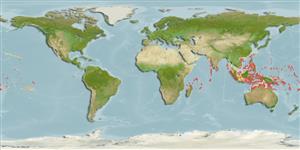Common names from other countries
Environment: milieu / climate zone / depth range / distribution range
Ecologia
marinhas associadas(os) a recifes; intervalo de profundidade 3 - 30 m (Ref. 11790). Tropical; 28°N - 18°S
Indo-Pacific: East Africa to the Hawaiian and Society islands.
Tamanho / Peso / Idade
Maturity: Lm ? range ? - ? cm
Max length : 10.0 cm SL macho/indeterminado; (Ref. 48637)
Espinhos dorsais (total): 0; Raios dorsais moles (total): 64-70; Espinhos anais 0; Raios anais moles: 51 - 47; Vértebras: 40 - 41. Body mottled brown with irregular dark and pale markings; 2-3 dark-edged ocelli along lateral line pectorals blackish distally; dorsal and anal fins with minute black dots; caudal fin with black spots (Ref. 6270). Gill rakers rudimentary (Ref. 1602).
Inhabits coral heads of lagoon and seaward reefs; common in shallow caves or under ledges and can lie flat against vertical rock surfaces (Ref. 1602, 48637). Found in rubble slopes in sand or fine-rubble patches (Ref. 9792). Benthic (Ref. 58302). Comes out at dusk and hunts on low reef. It has low profile and crawls along like a flatworm, but activity waves its black pectoral fin as it goes (Ref. 48637). Feeds on small benthic animals (Ref. 9792).
Life cycle and mating behavior
Maturidade | Reprodução | Desova | Ovos | Fecundidade | Larvas
Randall, J.E., G.R. Allen and R.C. Steene, 1990. Fishes of the Great Barrier Reef and Coral Sea. University of Hawaii Press, Honolulu, Hawaii. 506 p. (Ref. 2334)
Categoria na Lista Vermelha da IUCN (Ref. 130435)
CITES (Ref. 128078)
Not Evaluated
Ameaça para o homem
Harmless
Utilização humana
Pescarias: sem interesse
Mais informação
Nomes comunsSinónimosMetabolismoPredadoresEcotoxicologiaReproduçãoMaturidadeDesovaFecundidadeOvosDesenvolvimento dos ovos
ReferênciasAquaculturaPerfil para aquaculturaEstirpesGenéticaElectrophoresesHereditariedadeDoençasProcessamentoMass conversion
Ferramentas
Relatórios especiais
Descarregue XML
Fontes da internet
Estimates based on models
Preferred temperature (Ref.
115969): 26.7 - 29.3, mean 28.5 (based on 1748 cells).
Phylogenetic diversity index (Ref.
82804): PD
50 = 0.5000 [Uniqueness, from 0.5 = low to 2.0 = high].
Bayesian length-weight: a=0.01622 (0.00604 - 0.04358), b=2.94 (2.71 - 3.17), in cm Total Length, based on LWR estimates for this (Sub)family-body shape (Ref.
93245).
Nível Trófico (Ref.
69278): 3.5 ±0.37 se; based on food items.
Fishing Vulnerability (Ref.
59153): Low vulnerability (10 of 100).
